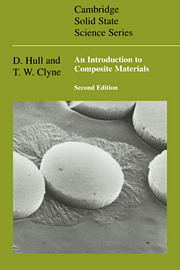Book contents
- Frontmatter
- Contents
- From the preface to First Edition
- Preface to Second Edition
- 1 General introduction
- 2 Fibres and matrices
- 3 Fibre architecture
- 4 Elastic deformation of long-fibre composites
- 5 Elastic deformation of laminates
- 6 Stresses and strains in short-fibre composites
- 7 The interface region
- 8 Strength of composites
- 9 Toughness of composites
- 10 Thermal behaviour of composites
- 11 Fabrication
- 12 Applications
- Appendix: Nomenclature
- Author index
- Subject index
1 - General introduction
Published online by Cambridge University Press: 05 June 2012
- Frontmatter
- Contents
- From the preface to First Edition
- Preface to Second Edition
- 1 General introduction
- 2 Fibres and matrices
- 3 Fibre architecture
- 4 Elastic deformation of long-fibre composites
- 5 Elastic deformation of laminates
- 6 Stresses and strains in short-fibre composites
- 7 The interface region
- 8 Strength of composites
- 9 Toughness of composites
- 10 Thermal behaviour of composites
- 11 Fabrication
- 12 Applications
- Appendix: Nomenclature
- Author index
- Subject index
Summary
Composites make up a very broad and important class of engineering materials. World annual production is over 10 million tonnes and the market has in recent years been growing at 5–10% per annum. Composites are used in a wide variety of applications. Furthermore, there is considerable scope for tailoring their structure to suit the service conditions. This concept is well illustrated by biological materials such as wood, bone, teeth and hide; these are all composites with complex internal structures designed to give mechanical properties well suited to the performance requirements. Adaptation of manufactured composite structures for different engineering purposes requires input from several branches of science. In this introductory chapter, an overview is given of the types of composite that have been developed.
Types of composite material
Many materials are effectively composites. This is particularly true of natural biological materials, which are often made up of at least two constituents. In many cases, a strong and stiff component is present, often in elongated form, embedded in a softer constituent forming the matrix. For example, wood is made up of fibrous chains of cellulose molecules in a matrix of lignin, while bone and teeth are both essentially composed of hard inorganic crystals (hydroxyapatite or osteones) in a matrix of a tough organic constituent called collagen (Currey 1983). Commonly, such composite materials show marked anisotropy – that is to say, their properties vary significantly when measured in different directions.
- Type
- Chapter
- Information
- An Introduction to Composite Materials , pp. 1 - 8Publisher: Cambridge University PressPrint publication year: 1996
- 3
- Cited by



